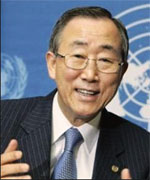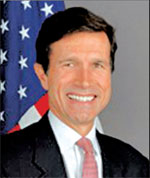Misrepresenting the humanitarian operation
Michael ROBERTS
The recent UNHRC resolution sponsored by USA and directed at the
government of Sri Lanka was the culmination of a campaign that began
during the last stages of Eelam War IV. Since 2010 articulate circles in
the West have been convinced that there had been ‘40,000 civilian
deaths’ during this phase. In contrast Rohan Gunaratna asserted that
there were 1,400 civilian deaths, of which 200 were inflicted by the
LTTE. Both calculations are erroneous.
Estimates provided by three moderate Tamils who have had regular
access to the Tamil personnel who were on the ground indicate that the
death toll, inclusive of Tamil Tiger personnel, was in the range 10,000
to 16,000, in circumstances where it was impossible to differentiate in
all cases between those Tiger, those recently conscripted as auxiliaries
and those truly civilian.

Ban Ki-Moon |

V. Anandasangaree |
It is towards the clarification of these specific circumstances and a
criticism of the claims presented by a variety of human rights agencies,
moral crusaders and media engines that this essay is directed. The
campaign has been sustained by a mixture of lies and half-truths amidst
truths, compounded further by a wilful blindness to the manner in which
the LTTE utilised the Tamil populace in its domain as labour pool,
protective shield and bargaining chip meant to induce a ‘humanitarian
intervention.’ The massaging of death toll figures, therefore, is just
one facet of a massive propaganda heist.
As the Sri Lanka Army advanced on three fronts, the LTTE lost control
of the A9 arterial road and its administrative capital at Kilinochchi by
January 1, 2009. Thereafter, its forces and the people they had herded
together were trapped in the Vanni Pocket, namely, the North Eastern
corner of the island between the A9 and the coast, a district-size chunk
of territory that shrank continuously as the government forces advanced
till the Tigers and remaining civilians - roughly 200,000 in crude
estimate - were sandwiched into 42 square kilometres in mid-April.
After the remaining Tiger terrain was captured by mid-May 2009, the
first estimates of the numbers killed that were presented by Holmes, the
UN representative, in Colombo, was 7,721. Further down the track his
former media officer at that time, Gordon Weiss appeared before the ABC
and claimed that the death toll was between 10,000 and 40,000. Even as
late as June 2011 the Times in London referred to 20,000 civilian dead
in the course of a summary review of the Sri Lankan war.
However, the UN Panel of Experts appointed on his own initiative by
Ban Ki-Moon presented their report (the Darusman report) in March 2011
and stated that the original figure of 7,721 was at the lower end of the
scale and there could have been 'as many as 40,000 deaths.'
In next to no time this speculation became hard fact in news items
from prestigious media chains. Thus, Kerry O'Brien of ABC asserted that
‘40,000 civilians were killed’ and spoke of the ‘brutal slaughter of
humans.’ The widespread acceptance of this type of claim was largely the
product of the emotional appeal of the Channel 4 documentary called
‘Killing Fields.’ Gordon Weiss chipped in by highlighting his position
under the rubric "Sri Lanka's ‘Srebenica Moment.”
The imagery associated with these two moments of state-organised
genocide in Kampuchea and Serbia had the impact they were designed to
arouse. Despite its weak evidential foundation and explicit surmise, the
figure of 40,000 became an established fact in some minds. Also occluded
was the character of the UN panel under Darusman and the appalling
analytical capacities displayed within its report.

Gordon Weiss |

Robert Blake |
Darusman report
It is remarkable that Ban Ki-Moon selected three individuals from a
legal background to undertake a survey of a military campaign in a land
with which they had limited geographical knowledge and no cultural
familiarity. The absence of military expertise and social science
capacities are immediately apparent in its coverage.
Independent academics working with the Marga Research Institution
Colombo have shown that there was 'a large lacuna (in this) information
gathering exercise'; that many sources were not divulged and that
significant omissions meant that the Panel relied 'on a one-sided body
of sources.' Indeed, the 'adversarial stance' taken by the Darusman
Panel resulted not only in findings marred by internal contradictions,
but also revealed a failure to comprehend 'the formidable challenge
which the government faced.'
This was a failure of contextualization and proportionality. A
balanced review cannot focus on death estimates without placing the
figure beside the number of Tamils, both Tiger and genuine civilian, who
survived. We now know that at around 280-290,000, including roughly
11,000 deemed Tiger, emerged alive from the crucible of the Vanni Pocket
between January and mid-May 2009.
By mid-April 2009 about 60,000 had reached the safety of government
territory by sneaking through on land or sea. On April 19-23 the army
breached the LTTE’s last redoubt in a remarkable operation. State media
images on TV and print revealed streams of people, including Tigers who
had downed arms, struggling across lagoon and dune to safety. As Reddy
from India described the scene, "an international and local media team
that visited the area on a military-conducted tour saw for itself the
terror-stricken faces." This mass has been variously estimated as
103,000, 106,000 and even 120,000, but it included many Tiger fighters
and such leading LTTE functionaries as Daya Master and George Master.
The Darusman report's failure to give weight to such events is quite
remarkable. This shortcoming is compounded by its refusal to give
adequate weight to the character of the LTTE regime.
The LTTE war machine
Prabhakaran has been described by former colleagues as well as Tamil
dissidents as a person who believed in the pre-emptive strike and the
killing of individuals who stood in his way. The LTTE had spurned the
opportunity of self-determination via negotiation in both 1995 and 2006.
Throughout the ceasefire-period 2002-06 it built up its military
capacities. This preparation included paramilitary training for
civilians.
When the LTTE initiated Eelam War IV in July 2006 it was confident of
success. Matters turned out different. By late 2007, their military
capacity in the Eastern Province had been reduced to nil. By January
2008, they lost control of the North Western coastline which had enabled
a supply of arms from India. Outgunned and out-manned, their troops were
forced into a retreat that moved from West to East for the most part.
They used landmines, bunds, trenches and booby traps to slow down the
government forces.
The LTTE also increased its conscription of civilians to build these
defences and replenish its troops. At the same time the civilian
population were induced to retreat en masse ahead of the battle lines -
moving from West to East. Though subject to multiple displacements,
these people faced limited danger at the outset in 2008. But from
January 2009 they were in increasing danger of being submerged in the
crossfire.
This was the LTTE's intent. The civilians were, now, not only a
source of labour and conscripts; they were also hostages shielding the
Tigers and providing a concern for humanitarian agencies which
intervened and sought a ceasefire from the warring parties. Since the
LTTE had no intention of releasing the Tamil people or respecting any
ceasefire, such interventions were in fact a form of military aid for
the LTTE. The humanitarian outcry raised by AI, HRW, ICG as well as some
Western leaders was also a potential escape route that would have
enabled the LTTE leadership to return to the fight another day.
The reasoning of the LTTE leadership was revealed subsequently by
Kumaran Pathmanathan (their principal logistics man abroad): "when I
reflect upon the past I think the LTTE leadership also had no choice. If
they released the people first, then only the Tigers would be left
there. Thereafter all of them could have been wiped out."
The shielding capacity of the mass of civilians was all the more
because, from 2008 if not earlier, most Tigers were fighting in
check-shirts, trousers, shorts and sarongs. The Sri Lanka Army's night
operations and the success of their snipers as well as the exigencies of
retreat encouraged such a policy. In a communiqu‚ on March 9, 2009
Blake, the US ambassador in Colombo, noted that "the LTTE maintains the
fiction that civilians do not want to leave. All evidence points to the
contrary: several civilians have been shot trying to escape, many others
have escaped." Anna Neistat of HRW was equally adamant on this point in
March 2009 after meeting Tamils in refugee camps who had fled the war
zone.
Though Weiss and the Darusman Report mention such facts, their
overall reviews downplay the significance and focus largely on the
government's role in the injury of ‘civilians’ through indiscriminate
shelling. Their estimates of the civilian dead simply gloss over the
difficulty of distinguishing civilian and Tiger; and attach little
weight to the fact that the LTTE was the creator of this circumstance:
the sandwich situation in which their own Tamil populace was placed and
their use as so many sandbags.
Channel 4 went further in manufacturing a lie: they asserted that the
Tamil “civilians were driven from their homes by government forces.”
Amidst numerous sources, the writings of the Hindu correspondent as well
as the Tamil journalist DBS Jeyaraj provide conclusive evidence against
such calumny. In a passionate essay in April 2009 Jeyaraj, a senior
Tamil journalist writing from Toronto, spoke of the situation of his
Tamil people under the LTTE as ‘an open prison’ and celebrated the
escape ‘from bondage’ of 103,000 ‘entrapped’ people that was secured by
an army operation between April 19 and 23, 2009.
To page 12
|



